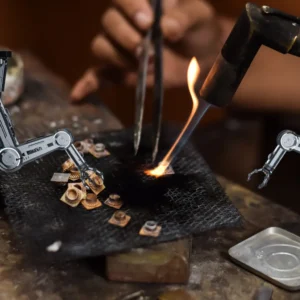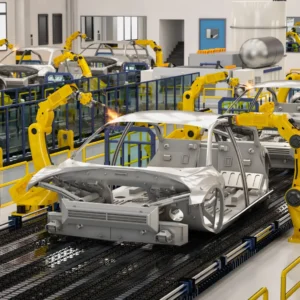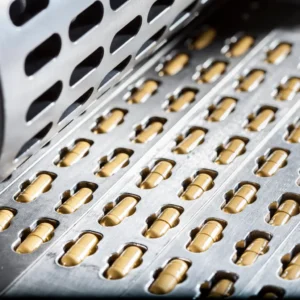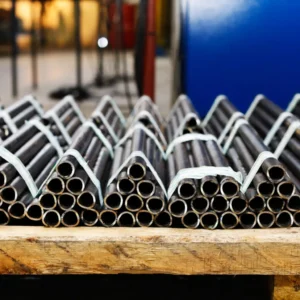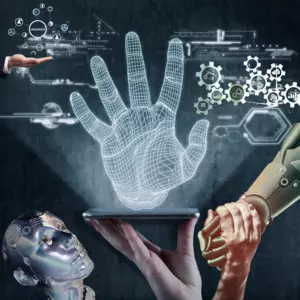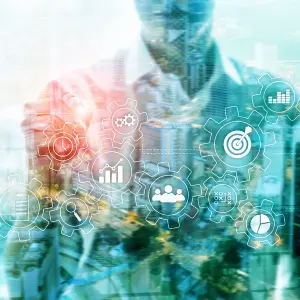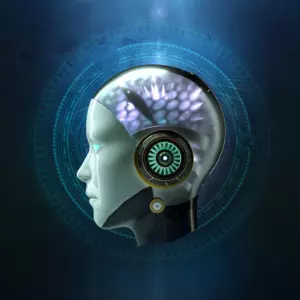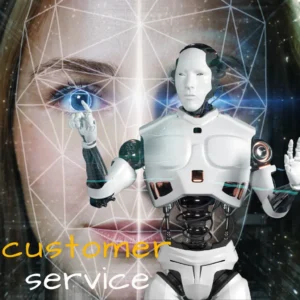
Molecular Models
AI in Chemical Manufacturing
Welcome to the “AI in Chemical Manufacturing” world, where science fiction becomes scientific fact. In this transformative journey, we delve into the very core of chemical production, where precision, innovation, and sustainability converge.
We’ll explore the profound impact of AI on chemical formulations, safety protocols, and logistics. We’ll witness the evolution of the periodic table itself, redefined by AI’s mastery.
As we prepare the next generation of chemical professionals to lead the charge, we invite you to embark on this fascinating voyage. Join us as we unravel the extraordinary possibilities, challenges, and questions that lie ahead in tomorrow’s chemistry.
Table of Contents
Precision in Chemical Formulations
In the realm of AI in Chemical Manufacturing, precision is paramount. Imagine crafting chemicals with an accuracy that borders on the molecular level. This is where AI steps in, revolutionizing the very core of chemical formulations.
Manufacturers can access raw materials with unprecedented efficiency by leveraging AI-driven supply chains for chemicals. This means faster production cycles and reduced costs. But the real magic happens in the formulation process itself.
ML in chemical reaction prediction plays a pivotal role. AI algorithms, honed through rigorous training, analyze vast datasets to predict how chemicals will interact. This isn’t mere guesswork; it’s science at warp speed.
Predictive analytics in chemical safety mitigates risks before they even materialize. Safety protocols are enhanced, ensuring a secure environment for both man and machine. But precision doesn’t stop at safety.
Every element in the periodic table plays a crucial role in chemical formulations. AI can fine-tune the ratios and compositions with unparalleled accuracy, driving breakthroughs in sustainable chemical research. The result? Greener, eco-friendly solutions that redefine the industry.
But how does AI achieve such precision? The answer lies in the evolution of training chemists for the AI era. This synergy of human expertise and artificial intelligence is the future of chemical manufacturing. So, what’s next? How does AI predict chemical interactions? Let’s delve into it.
Predicting Chemical Interactions with AI
From precision in formulations, we now venture into the realm of predicting chemical interactions with the aid of AI in Chemical Manufacturing. How does AI make these forecasts with such precision? Let’s uncover the magic.
Through ML in chemical reaction prediction, AI algorithms meticulously analyze colossal datasets. Finely tuned through rigorous training, these algorithms decipher the intricate dance of atoms and molecules. They predict reactions, unlocking a new era of chemical innovation.
But it doesn’t stop there. Predictive analytics in chemical safety bolster this process. By foreseeing potential hazards, AI enhances safety protocols to safeguard the environment and the workforce. It’s a symphony of technology and expertise, revolutionizing chemical production.
Imagine a chemist armed with knowledge and a virtual assistant capable of instantly assessing countless variables. This is the future where human intuition meets AI precision. Together, they pioneer the next generation of chemical formulations.
Yet, as we delve into this futuristic landscape, questions arise. How can we further fortify safety in chemical processes? How can we ensure that our operations run smoothly without any interruptions? Join us in exploring the vital topic of Enhancing Chemical Safety Protocols.
Enhancing Chemical Safety Protocols
As we journey through the transformative landscape of AI in Chemical Manufacturing, we’ve witnessed AI’s remarkable ability to predict chemical interactions. Now, let’s focus on the paramount aspect of safety.
With the predictive power of AI, we can preempt potential risks. Predictive analytics in chemical safety ensures that safety protocols are reactive and proactive. AI scans data to identify patterns and anomalies, alerting us to potential hazards before they escalate.
Imagine an AI system constantly monitoring your chemical operations, providing real-time feedback and warnings. It’s like having a vigilant guardian for your workforce and the environment.
Furthermore, this isn’t just about preventing accidents but optimizing processes. AI-driven chemical supply chains ensure that suitable materials are available when needed, reducing the risk of last-minute rushes or stockpiling dangerous substances.
But there’s a burning question: How can we streamline the logistics for chemical supplies without compromising safety? Join us as we delve into this critical topic of Streamlined Logistics for Chemical Supplies.
Streamlined Logistics for Chemical Supplies
Having fortified chemical safety protocols through AI, the next frontier in AI in Chemical Manufacturing beckons – streamlining the logistics of chemical supplies. But how can we ensure that chemical movement is efficient and secure?
Imagine a scenario where AI-driven systems anticipate your chemical needs. They predict the required chemicals and when and where they should be delivered. This level of precision stems from predictive analytics in chemical safety, ensuring that supplies align with safety standards.
Furthermore, AI-driven supply chains for chemicals can reduce waste and costs. By optimizing the routes and quantities of chemical shipments, we can minimize environmental impact while bolstering economic efficiency.
But the crux of the matter is ensuring the handling of chemicals in transit is as safe as their production. So, how can we address this challenge effectively? How can we handle hazardous chemicals with robots, transforming the landscape of chemical logistics? Join us as we dive into this intriguing topic of Handling Hazardous Chemicals with Robots.
Handling Hazardous Chemicals with Robots
In our exploration of AI in Chemical Manufacturing, we’ve seen how AI can enhance chemical safety protocols and streamline logistics. Now, let’s delve into the innovative domain of handling hazardous chemicals with robots, where precision and safety converge.
Robots with advanced AI can navigate the intricate task of transporting dangerous substances. Imagine robots seamlessly transferring chemicals within highly controlled environments, reducing human exposure and risks. This synergy between robotics in chemical handling and AI ensures safety while optimizing operations.
These robotic systems are more than mere automatons; they’re intelligent collaborators. They utilize ML in chemical reaction prediction to respond swiftly to unexpected situations, preventing accidents before they occur. Their constant vigilance, paired with predictive analytics, safeguards both personnel and the environment.
But here’s the tantalizing question: Can we push this innovation further? How can robots handle hazardous chemicals and contribute to breakthroughs in eco-friendly chemical research? Join us as we uncover the evolving landscape of sustainable chemistry in the era of AI.
Breakthroughs in Eco-Friendly Chemical Research
As we journey through the possibilities of AI in Chemical Manufacturing, we’ve witnessed the remarkable potential of robots in handling hazardous chemicals. Now, let’s explore how these advancements steer us towards a greener, more sustainable future in chemical research.
Robots equipped with AI are efficient chemical handlers and catalysts for green chemical manufacturing. Their reaction precision and ability to predict outcomes contribute to developing eco-friendly formulations. The result? Reduced environmental impact and a more sustainable industry.
In this new era, the periodic table isn’t static; it’s evolving with AI-driven discoveries. Breakthroughs in sustainable chemical research are now on the horizon, ushering in innovative materials and processes that redefine the chemistry landscape. Imagine chemicals designed with sustainability in mind from their inception.
But here’s the intriguing question: How can we scale these innovations? How can we integrate green operations seamlessly into chemical production? Join us in our next exploration of Green Operations in Chemical Production as we uncover the path to a more sustainable chemical industry.
Green Operations in Chemical Production
Having explored the transformative potential of AI in fostering eco-friendly chemical research, we now dive into the realm of green operations in chemical production. How can we translate breakthroughs into sustainable practices on a large scale?
The answer lies in the seamless integration of sustainability into every facet of chemical production. By harnessing AI in sustainable chemical research, we pave the way for greener formulations and processes. But the true catalyst for change is incorporating these discoveries into daily operations.
AI plays a pivotal role in optimizing processes for sustainability. ML in chemical reaction prediction ensures that reactions are efficient and environmentally friendly. By harnessing the power of predictive analytics, we can make better decisions about resource usage. This reduces waste and leads to a more sustainable future with reduced energy consumption.
Furthermore, as highlighted before, an AI-driven supply chain can source materials with sustainability in mind. This means chemicals sourced and transported with the most negligible environmental impact.
But here’s the vital question: How do we prepare the next generation of chemical professionals to champion these green operations effectively? What skills and knowledge will they need to thrive in the AI-driven, eco-conscious chemical industry? Join us in our next exploration of Preparing the Next-Gen Chemical Workforce to find out.
Preparing the Next-Gen Chemical Workforce
Having journeyed through the evolution of green operations in chemical production, we find ourselves at a pivotal juncture. As the chemical industry embraces sustainability and AI in Chemical Manufacturing, How do we equip the next generation of professionals to navigate this dynamic landscape?
Future chemists must be well-versed in traditional chemical principles and the nuances of AI integration. They need to understand the intricacies of predicting chemical interactions with AI and harnessing the potential of robotics in chemical handling for both efficiency and safety.
Moreover, the curriculum must adapt to emphasize the importance of eco-friendly chemical research, ensuring that budding scientists can innovate with sustainability in mind. They must grasp the significance of reducing environmental impact and creating a more sustainable chemical industry.
However, the challenges extend beyond scientific knowledge. Green operations in chemical production require a shift in mindset and a commitment to sustainability. Future professionals must be able to analyze and optimize processes using AI-driven data, contributing to environmentally conscious practices.
So, what lies ahead for the pioneers of the chemical industry? How can they lead the charge in chemical innovations, taking us further into the future of sustainable and AI-driven chemistry? Join us in our next exploration to find out.
Leading the Charge in Chemical Innovations
As we reflect on preparing the next-gen chemical workforce, it’s clear that they will play a pivotal role in driving chemical innovations in the era of AI in Chemical Manufacturing. But what does it mean to lead the charge in this transformative journey?
Leading in chemical innovations involves embracing the fusion of human expertise and AI-driven precision. It means harnessing the power of ML in chemical reaction prediction to discover new reactions, optimize processes, and reduce waste. Imagine a world where chemical safety is an absolute priority. Picture a workplace that is not only safe but also efficient. Leaders in this field understand the power of predictive analytics and utilize it to create safer environments and streamline operations. But that’s not all. These pioneers also champion sustainability, recognizing the importance of eco-friendly chemical research. They work tirelessly to develop greener chemicals and sustainable production methods, ensuring our planet remains healthy and vibrant for future generations.
But a question beckons us: How can AI push the boundaries of innovation even further? What lies in the future beyond our current understanding of chemistry? Join us in our next exploration as we delve into the fascinating concept of the Evolving Periodic Table of AI.
The Evolving Periodic Table of AI
Building on the foundation of leading chemical innovations in the age of AI in Chemical Manufacturing, we find ourselves on the cusp of a revolution – the evolution of the periodic table itself. But what does this transformation entail, and how does AI play a role in reshaping the fundamental elements of chemistry?
Picture a periodic table infused with AI-driven insights. Elements are not just chemical entities but dynamic, responsive, and adaptable. ML in chemical reaction prediction fuels this evolution, allowing us to manipulate elements with unprecedented precision, creating materials and compounds previously unimaginable.
In this new era, the periodic table becomes a canvas for innovation. Elements are no longer static; they respond to our commands, and chemical properties can be tailored with the precision of a symphony’s maestro.
As we explore the boundaries of AI-enhanced chemistry, we must ask: How will this evolving periodic table redefine the possibilities of chemical manufacturing? What untapped frontiers will it unlock, and how will it shape the future of our world? In the concluding chapter of our journey, we’ll seek answers and a glimpse into the future of chemistry with AI.
Conclusion
Our journey has been nothing short of extraordinary in the world of AI in Chemical Manufacturing. We’ve seen how AI’s precision enhances chemical formulations, predicts interactions, and elevates safety protocols.
AI’s influence extends beyond the laboratory, optimizing supply chains and handling hazardous chemicals with the finesse of automation. But it doesn’t stop there; AI is our guide in pioneering sustainable chemical research and operations, championing a greener industry.
As we prepare the next-gen chemical workforce, we equip them to lead the charge in chemical innovations. They leverage AI’s predictive power to shape the future of chemistry, transforming the very essence of the periodic table.
The periodic table evolves in response to our imagination, driven by AI’s mastery of ML in chemical reaction prediction. It empowers us to craft materials with unmatched precision, unlocking new frontiers in chemistry.
As we conclude our journey, we must ponder: How will this evolving periodic table reshape chemical manufacturing? How will it redefine our world, leading us toward a more sustainable, efficient, and innovative future?
The age of AI in Chemical Manufacturing is a tapestry of precision, safety, sustainability, innovation, and transformation. It is a testament to human ingenuity, aided by the power of artificial intelligence. And as we look ahead, the question remains: What new horizons will AI unveil in tomorrow’s chemistry?
Related Articles
- AI in Paper Manufacturing: Pulp and Processors
- AI in Agri-Equipment Manufacturing: Fields and Functions
- AI in Footwear Manufacturing: Steps Ahead
- AI in Jewellery Manufacturing: Gems and Generative Models
- AI in Glass Manufacturing: Crystal Clear Computing
- AI in Construction Material Manufacturing: Bricks and Bytes
- AI’s Role in Electronic Manufacturing: Circuitry and Systems
- AI’s Revolution in Polymer Production: Reshaping Plastics
- AI in Furniture Manufacturing: Crafted by Code
- AI in Ceramic Production: Fired by Future
- AI in Food Manufacturing: Savory Systems
- AI in Metal Fabrication: Moulded by Machines
- AI in Aerospace Manufacturing: Beyond the Atmosphere
- AI’s Integration in Pharmaceutical Manufacturing: Pills and Processes
- AI in the Automotive Industry: Driving Production
- Weaving AI into Textile Manufacturing: Threads and Tech
- IPA in Manufacturing Sector: How AI Tools Revolutionize Efficiency, Productivity, and Quality

Arindam Roy
An Automation Consultant with 25+ years of IT Experience
Forbes Articles related to AI usage in the Manufacturing Sector:


